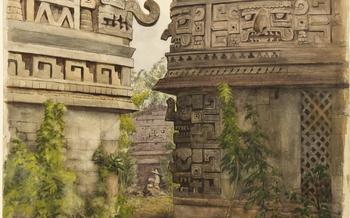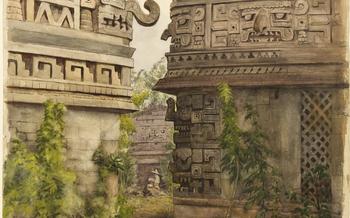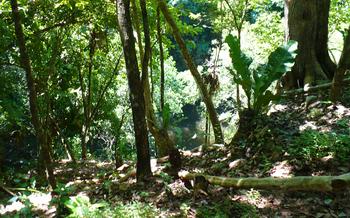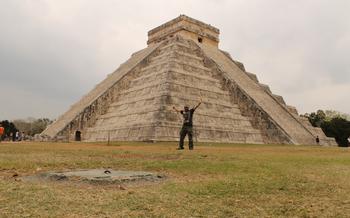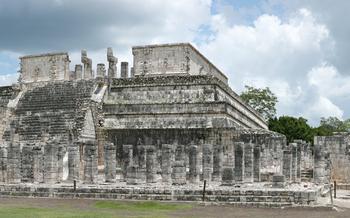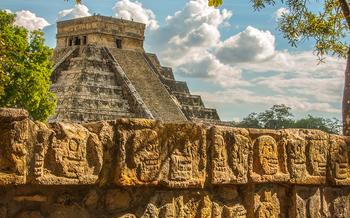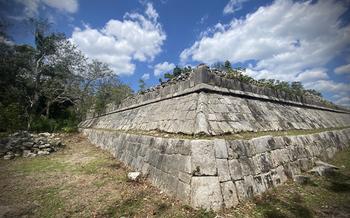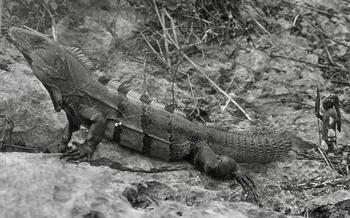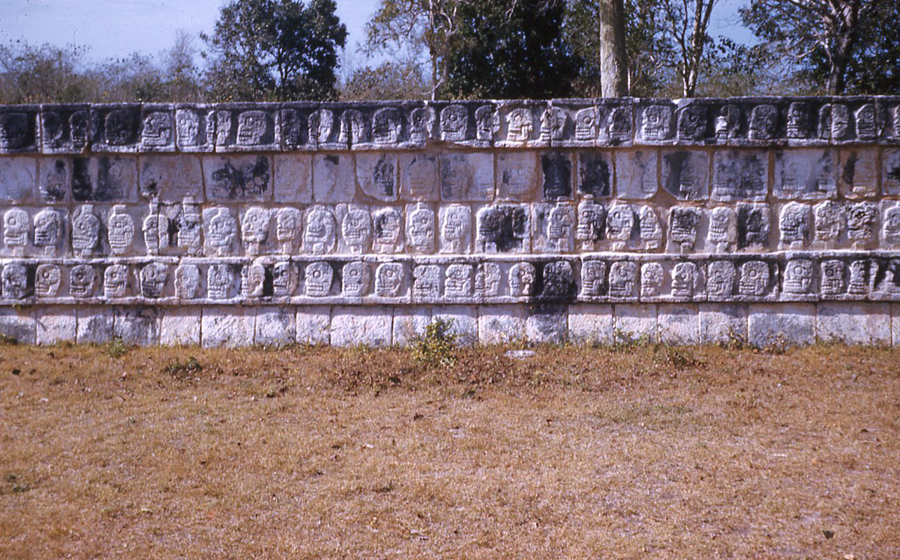
Cenote Tankah
- Chichen Itza: Unveiling the Ancient Mayan Wonder
- Getting to Chichen Itza
- Exploring Chichen Itza
- Cenote Tankah's Enchanting Waters
- Cenote Tankah's Unique Ecosystem
- Visiting Cenote Tankah
- Location and Accessibility
- Facilities and Amenities
- Entrance Fees and Regulations
- Recommended Time for a Visit
- Chichen Itza and Cenote Tankah Tour Packages
- What to Bring: Packing Essentials for Chichen Itza and Cenote Tankah
- Safety Precautions
- Photography Tips
- Local Cuisine:
- Cultural Etiquette
- Insider Tip: Unlocking Hidden Gems
Chichen Itza: Unveiling the Ancient Mayan Wonder
Historical significance: Chichen Itza, an ancient Mayan city located on the Yucatan Peninsula of Mexico, stands as a testament to the remarkable civilization that thrived here centuries ago. Once a bustling center of political, cultural, and religious activity, Chichen Itza served as the capital of the powerful Mayan state of Mayapan from the 10th to the 13th century. Its impressive ruins, a UNESCO World Heritage Site, offer a glimpse into the sophisticated urban planning, architectural prowess, and rich cultural traditions of the Maya.
Preservation efforts: Over the years, Chichen Itza has undergone extensive preservation and restoration efforts to protect its fragile structures and preserve its historical integrity. Archaeological excavations and research have played a vital role in uncovering the secrets of this ancient city, while ongoing conservation projects aim to ensure that Chichen Itza remains a source of inspiration and wonder for generations to come. Visitors can marvel at the remarkable preservation of iconic landmarks like the Kukulkan Pyramid, the Temple of Warriors, and the Great Ball Court, which continue to showcase the architectural brilliance of the Mayan civilization.
Unique architectural features: Chichen Itza is renowned for its unique architectural features, which reflect the advanced engineering and artistic skills of the Maya. One of the most striking structures is the Kukulkan Pyramid, also known as El Castillo, which dominates the city's skyline. This impressive step pyramid features 365 steps, symbolizing the Mayan solar calendar, and is adorned with intricate carvings depicting feathered serpents, warriors, and scenes from Mayan mythology. The city also boasts the Great Ball Court, the largest of its kind in the Mayan world, where ancient Mesoamerican ball games were played with a heavy rubber ball.
Cultural impact: Chichen Itza's cultural impact extends far beyond its physical remains. The city played a pivotal role in the development of Mayan civilization, serving as a religious, political, and economic hub. Its influence can be seen in the intricate writing system, advanced mathematical knowledge, and sophisticated astronomical observations that the Maya developed. Chichen Itza's legacy continues to inspire contemporary Mayan communities and serves as a reminder of the enduring cultural heritage of the region.
Getting to Chichen Itza
Chichen Itza is conveniently accessible from several major tourist destinations in Mexico.
From Cancun and the Riviera Maya, Chichen Itza is about a 2-hour drive. Numerous tour operators offer organized excursions, with round-trip transportation and guided tours included. If you prefer independent travel, rental cars are widely available.
From Merida, the capital of Yucatan, the journey takes approximately 4 hours by car. Guided tours are also available from Merida, providing insights into the history and significance of Chichen Itza.
No matter your preferred mode of transport, whether it's a guided tour or independent travel, getting to Chichen Itza is a breeze. Choose the option that best suits your budget and preferences, and embark on a journey back in time to explore this magnificent Mayan city.
Exploring Chichen Itza
Delving into the ancient city of Chichen Itza is a journey through time, unlocking the mysteries of the Mayan civilization. As you wander amidst the awe-inspiring ruins, each structure whispers tales of a rich past.
The most iconic landmark is the Kukulkan Pyramid, a testament to Mayan architectural prowess. Its 365 steps, representing the days of the solar year, lead to a breathtaking view from the top. The pyramid's alignment with the sun during the spring and autumn equinoxes casts a mesmerizing shadow, creating the illusion of a serpent slithering down the steps—a phenomenon that encapsulates the Mayan fascination with astronomy.
Another highlight is the Great Ball Court, the largest in Mesoamerica. Imagine the roar of the crowd as ancient athletes engaged in a ritualistic ball game, the outcome of which held deep spiritual significance.
The Temple of Warriors, with its intricate carvings and imposing columns, pays homage to the military prowess of the Maya. Its walls depict fierce battles and scenes of sacrifice, offering a glimpse into the complex social and religious practices of this ancient civilization.
Beyond these iconic structures, Chichen Itza conceals hidden treasures waiting to be discovered. Scattered throughout the site are smaller temples, altars, and plazas, each with its own unique story to tell.
Cenote Tankah's Enchanting Waters
Swim, snorkel, and unravel the mysteries of Cenote Tankah's enchanting waters. Immerse yourself in the crystal-clear depths and discover a hidden world teeming with marine life. Glide through underwater caves and tunnels, marveling at the intricate rock formations that have been sculpted by time and water.
As you explore, let your imagination run wild as you listen to the local legends and myths that surround this sacred cenote. Hear tales of ancient Mayan rituals and ceremonies that took place within these mystical waters, and feel a connection to the rich cultural heritage of the region.
Snorkeling and diving enthusiasts will be thrilled by the diverse marine life that calls Cenote Tankah home. Spot colorful fish darting among the coral reefs, turtles gliding gracefully through the water, and perhaps even a playful family of manatees.
Cenote Tankah is not just a natural wonder but also a vital part of the local ecosystem. The cenote's waters provide a habitat for numerous aquatic plants and wildlife, including endangered species. Conservation efforts are in place to protect this fragile ecosystem and ensure its preservation for generations to come.
Cenote Tankah's Unique Ecosystem
Geological Formations: The geological formations of Cenote Tankah are truly remarkable and contribute to its unique character. The cenote is situated within a limestone bedrock, which has been eroded and dissolved by water over thousands of years, resulting in the creation of the stunning cavern system and underground tunnels. Visitors can observe various geological features such as stalactites, stalagmites, and intricate rock formations that adorn the cenote walls and ceiling, providing a sense of awe and wonder.
Aquatic Plants and Wildlife: Cenote Tankah's crystal-clear waters support a diverse array of aquatic plants and wildlife, showcasing the intricate biodiversity of the region. Submerged aquatic plants such as water lilies and ferns create a vibrant green tapestry, adding to the cenote's allure. The waters teem with a variety of fish species, including colorful tropical fish and even the occasional turtle. Keep an eye out for the resident catfish, which are known for their playful nature and interaction with visitors.
Cenote's Role in the Mayan Civilization: Cenotes held great cultural and practical significance for the ancient Maya civilization. They served as a vital source of fresh water, particularly during the dry season when other water sources were scarce. The Maya also believed that cenotes were portals to the underworld and were often used for religious ceremonies and rituals. Offerings were made to the gods, and cenotes were considered sacred places where the Maya could communicate with the divine.
Visiting Cenote Tankah
Location and Accessibility
Cenote Tankah is conveniently located about 20 minutes drive from Chichen Itza, making it an ideal addition to any trip to the ancient city. It is easily accessible by car or taxi, and there are several tour operators that offer day trips that include a visit to both Chichen Itza and Cenote Tankah.
Facilities and Amenities
The cenote is well-equipped with facilities to ensure a comfortable and enjoyable visit. There are changing rooms, showers, and restrooms on-site, as well as a small restaurant serving snacks and refreshments. Visitors can also rent snorkeling gear and life jackets for a small fee.
Entrance Fees and Regulations
Admission to Cenote Tankah is subject to a small entrance fee, which typically includes access to the cenote, changing rooms, and restrooms. Snorkeling gear rental and guided tours are available at an additional cost. It is important to note that swimming and snorkeling are only permitted in designated areas to ensure the safety of visitors and the preservation of the cenote's delicate ecosystem.
Recommended Time for a Visit
The best time to visit Cenote Tankah is during the early morning or late afternoon when the sun is not directly overhead, and the water is at its clearest. This allows for the best visibility for snorkeling and swimming. It is also advisable to avoid visiting during peak tourist season to avoid crowds and ensure a more tranquil experience.
Chichen Itza and Cenote Tankah Tour Packages
Convenience and Customization:
For a hassle-free experience, consider booking a guided tour that combines a visit to Chichen Itza and Cenote Tankah. These tours offer several advantages, including:
-
Transportation: Convenient transportation from your hotel or a designated meeting point, eliminating the need for self-driving or arranging separate transportation.
-
Professional Guides: Knowledgeable and experienced guides who provide insights into the history, culture, and significance of Chichen Itza and the cenote, enhancing your understanding and appreciation.
-
Itinerary Customization: Many tour operators offer customizable itineraries, allowing you to tailor the tour to your interests and preferences. Choose from various options, such as extended time at specific sites, additional activities, or personalized recommendations.
-
Hassle-Free Experience: With a guided tour, you can relax and enjoy the attractions without worrying about logistics, such as entrance fees, permits, or finding your way around.
Booking Tips for the Best Deals:
-
Advance Booking: To secure the best deals and availability, book your tour in advance, especially during peak tourist seasons.
-
Compare Prices and Inclusions: Compare prices and inclusions offered by different tour operators to find the best value for your money. Read reviews and ratings to assess the quality of services provided.
-
Group Discounts: If traveling with a group, inquire about group discounts or special offers.
-
Consider Combo Packages: Look for tour packages that combine Chichen Itza and Cenote Tankah with other popular attractions in the region, such as Tulum or Valladolid, for a comprehensive and cost-effective experience.
What to Bring: Packing Essentials for Chichen Itza and Cenote Tankah
Chichen Itza:
- Sunscreen and Hat: The sun can be intense in Chichen Itza, so protect your skin with a high-SPF sunscreen and a wide-brimmed hat.
- Comfortable Shoes: You'll be doing a lot of walking on uneven surfaces, so wear comfortable, closed-toe shoes with good traction.
- Water Bottle: Staying hydrated is crucial, especially in the hot and humid climate. Bring a reusable water bottle and fill it up throughout the day.
- Camera: Capture the stunning beauty of Chichen Itza with a camera or smartphone. Remember to be respectful of others when taking photos.
- Binoculars: If you're a bird lover, bring binoculars to spot the diverse bird species that inhabit the area.
Cenote Tankah:
- Swimsuit and Cover-Up: Pack a swimsuit and a cover-up for swimming and snorkeling in the cenote.
- Snorkeling Gear: If you don't have your own snorkeling gear, you can rent it at the cenote. However, if you have your own, bring it along to save money.
- Underwater Camera: Capture the vibrant underwater world of the cenote with an underwater camera or waterproof housing for your smartphone.
- Towel: Bring a towel to dry off after swimming or snorkeling.
- Picnic Lunch: Pack a light lunch and snacks to enjoy at the cenote. There are usually picnic tables or designated areas for eating.
Safety Precautions
When exploring Chichen Itza and Cenote Tankah, safety should be a top priority. Here are some essential precautions to take:
-
Sun Protection: The sun can be intense in Mexico, so apply sunscreen regularly, especially if you'll be spending extended periods outdoors. Wear protective clothing like hats and sunglasses to shield yourself from the sun's harmful rays.
-
Hydration and Snacks: Bring plenty of water to stay hydrated throughout the day, particularly if you're engaging in activities that involve physical exertion. Pack some snacks to replenish your energy levels as needed.
-
Insect Repellent and First Aid Kit: To avoid insect bites and stings, carry insect repellent with you. Pack a basic first aid kit containing essential supplies for treating minor injuries or ailments.
-
Safety Guidelines for Swimming and Snorkeling: Follow the safety guidelines provided at Cenote Tankah. Wear appropriate swimwear and use a life jacket if necessary. Be cautious when entering and exiting the cenote, as the steps can be slippery. Snorkelers should stay within designated areas and be aware of their surroundings.
Photography Tips
Capturing the essence of Chichen Itza and Cenote Tankah through photography is an incredible way to preserve memories and share the beauty of these places with others. Here are some tips to help you take stunning photographs:
-
Composition and Lighting: Choose the right angles and lighting conditions to enhance your shots. Experiment with different perspectives to create dynamic compositions. The golden hours, just after sunrise and before sunset, offer the best lighting for capturing the vibrant colors of the ruins and the cenote's crystal-clear waters.
-
Underwater Photography: For capturing the underwater world of Cenote Tankah, a waterproof camera or housing is essential. Use natural light to illuminate the cenote's depths, and consider using a wide-angle lens to capture the vastness of the underwater scenes.
-
Instagram-worthy Shots: For Instagram enthusiasts, capturing unique and visually appealing shots is key. Experiment with different angles, perspectives, and editing techniques to create eye-catching photos. Utilize natural elements like the sun's rays or the cenote's reflections to add depth and drama to your images.
-
Respecting Cultural Sensitivity: Remember that Chichen Itza is a sacred site for the Mayan people. Be respectful when taking photos, and avoid capturing images that may be considered culturally inappropriate or disrespectful. Ask permission before photographing local people, and always treat them with courtesy and respect.
Local Cuisine:
Immerse yourself in the vibrant flavors of Mayan cuisine during your visit to Chichen Itza. Indulge in traditional dishes that have been passed down through generations, showcasing the region's unique culinary heritage. Sample the delectable Cochinita Pibil, a slow-roasted pork dish infused with achiote paste and wrapped in banana leaves. Savor the fresh flavors of Panuchos, a fried tortilla topped with black beans, turkey or chicken, and a tangy tomato sauce. Tantalize your taste buds with Salbutes, another fried tortilla dish adorned with shredded turkey or chicken, lettuce, tomato, and avocado. For a refreshing treat, try Horchata, a sweet and creamy beverage made from rice, cinnamon, and sugar. Vegetarian and vegan travelers will find a variety of options, such as Papadzules, a dish of corn tortillas filled with chaya leaves and topped with a pumpkin seed sauce. Explore the local markets and restaurants to discover the authentic flavors of Mayan cuisine and support the local community.
Cultural Etiquette
When interacting with the local Mayan communities, it is essential to be respectful and mindful of their traditions and customs. A warm greeting with a genuine smile can go a long way. Remember to address individuals politely, using "Señor", "Señora", or "Señorita", followed by their name.
Respecting Mayan traditions and beliefs is paramount. Refrain from touching or climbing on ancient structures, as they hold deep cultural and religious significance. If you encounter Mayan ceremonies or rituals, maintain a respectful distance and avoid disturbing the proceedings.
Bargaining is a common practice in local markets, but always approach it with respect. Be prepared to negotiate prices politely and start with a fair offer. Tipping is customary in restaurants and for services rendered, but do so discreetly and appropriately.
When visiting sacred sites, such as the Chichen Itza ruins, dress modestly and behave respectfully. Avoid loud noises, refrain from using flash photography, and follow any specific guidelines or restrictions posted at the site.
By embracing cultural etiquette, you not only show respect for the local people and their traditions but also enhance your travel experience and create meaningful connections with the Mayan community.
Insider Tip: Unlocking Hidden Gems
Venture beyond the popular tourist trails to discover hidden cenotes tucked away in the lush Yucatan jungle. Explore the nearby Ek Balam ruins, a lesser-known Mayan site with impressive architecture and fewer crowds. For a unique experience, take a guided night tour of Chichen Itza to witness the mesmerizing light and sound show illuminating the ancient ruins. Ascend the pyramid of Cobá, another ancient Mayan city, for breathtaking panoramic views of the surrounding jungle. Embrace the local culture by visiting traditional Mayan villages and markets, where you can interact with the friendly locals, learn about their customs, and find unique souvenirs.
